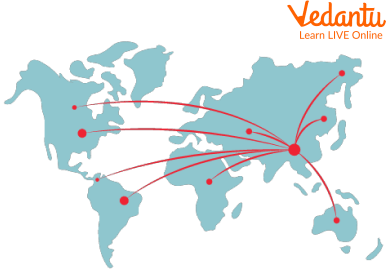




An Overview of Human Migration
Human civilisation is one of the most interesting aspects of the school’s history textbooks. The stories of ancient humans and their migration and evolution never fail to amaze the history aspirants. Over the last few decades, with the help of many types of research and theories, historians have figured out a lot about early human migration.
In this article, we will try to cover as much as possible about migration for kids, and their circumstances. We will also learn why and how did early humans migrate. No single story or research text can cover such an immense period and area in ancient history. We will attempt to understand more about their migration and why did early humans migrate, which took place hundreds of centuries ago.
Human Migrations Timeline
Over the last few decades, there has been a lot of research and discoveries in the field of ancient human fossils. This has led to the rise of multiple theories about migration for kids and its timelines.
Early human migration was the movement of our ancestors in prehistoric times, from one place to other in search of the adequate climatic conditions and resources required to survive their lives. According to most of the theories, the earliest humans are believed to be developed out of australopithecine ancestors. This happened about 3 million years ago in the regions of Eastern Africa.
Reason for Early Human Migration
There can be multiple reasons for the migration of the human race. It is said the development of language happened somewhere around 50,000 years ago. This helped humans to communicate among themselves and allowed them to find solutions to their problems. With this evolved ability to think and speak, humans began looking for solutions to the needs around them, which led to their migration.

Early Human Migration
Although no one can confirm the exact reason for their migration from the African continent, most studies and researches tell that it was due to the depletion of resources in the continent. The most important reason must be the lack of water resources as an average human needs around 2-3 litres per day to survive well. Humans began to think and assess their situation and act upon the required deeds. When they would understand that they are out of any resources, they would migrate and colonize other areas of the continents where the resources were available.
Early Human Migration Routes
We learned that the earliest race of humans originated on the African continent. The earliest fossils of recognizable Homo sapiens that were found through many types of research in Ethiopia trace back to approximately 200,000 years old. It is believed that after leaving the African continent, humans followed the coasts where abundant resources were available.
The first wave of migration occurred somewhere between 90 thousand and 30 thousand years ago. This wave moved across the Middle East's areas, into Southern Asia's regions, and down to the Australian continent. Some thousand years later, additional waves of migration followed. Between 40,000 and 12,000 years ago, our ancestors migrated towards the north into Europe. The icy conditions in the northern belt at the time helped expand early humanity's territory.
Other sources suggest that about 15,000 years ago, North American migration began. Over the next few thousand years, humans eventually spread into South America and pushed into the eastern regions, which are now the eastern United States and Canada.

Migration Routes on the World Map
How did Early Humans Migrate?
Due to the lack of availability of resources, the population used to rise and fall very often. Africa has a wide range of environments, including deserts, lakes, rivers, and mountains. To find the resources they need, such as food, water, and shelter, humans used to go out in small subsets to look out for solutions to their needs. Often these groups used to spread, leaving the original groups. Sometimes they used to return and rejoin their groups and migrate along. In this manner, humans spread across the globe and colonised different parts of different continents.
Summary
Now, we know that humans are the only species on this planet who have successfully populated and adapted to various land regions across the Earth. In this article, we learned how the first modern humans, called Homo Sapiens, migrated to different areas of the world.
Our ancestors began their migration from Africa around 70 to 100 thousand years ago and spread to all corners of the Earth while exploring. This spread of humanity, driven by the necessity of adequate climatic conditions and food resources, facilitated global expansion over the centuries.
FAQs on Early Human Migration
1. What was the colour of the first human?
Around 1.5 to 1.8 million years ago, Homo sapiens evolved dark skin. Like their closest human relative, chimpanzees, the early humans had pale skin.
2. Why did humans lose their fur?
Unlike other mammals, humans lack a dense layer of protective fur or hair. Theories claim that over the centuries, humans have become hairless so that they can have better temperature control in different types of climatic conditions.
3. What are the 3 human races?
It is said that the human population, in general, has been divided into three major races. These 3 races are Caucasoid, Negroid, and Mongoloid. Each race has its own set of unique characteristics.









